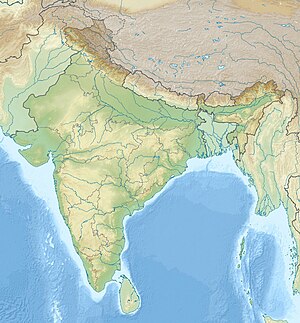Rihand Dam
| Rihand Dam | |||||||
|---|---|---|---|---|---|---|---|
|
|||||||
|
|
|||||||
| Coordinates | 24 ° 12 '10 " N , 83 ° 0' 30" E | ||||||
| Data on the structure | |||||||
| Construction time: | 1954-1952 | ||||||
| Height of the barrier structure : | 91 m | ||||||
| Building volume: | 1.63 million m³ | ||||||
| Crown length: | 934 m | ||||||
| Crown width: | 7.3 m | ||||||
| Power plant output: | 300 MW | ||||||
| Data on the reservoir | |||||||
| Altitude (at congestion destination ) | 268.22 m | ||||||
| Water surface | 465.39 km² | ||||||
| Reservoir length | 48 km | ||||||
| Storage space | 10600 million m³ | ||||||
| Catchment area | 13 179 km² | ||||||
The Rihand Dam (also called "Govind Ballabh Pant Sagar") is located in Pipri in the Sonbhadra District near Mirzapur in India .
It is located in the triangle between the states of Chhattisgarh , Madhya Pradesh and Uttar Pradesh on the Rihand River , a tributary of the Son . The reservoir is named after Uttar Pradesh's first Chief Minister Govind Ballabh Pant .
There are other rivers that flow into the reservoir intermittently or all year round: Kanchan, Mayar and Azir. The region around the reservoir is called Singrauli and is known for its coal deposits. That is why there are a number of power plants around the lake.
Building data

The barrier structure of the Rihand dam is a straight gravity dam made of concrete with a length of 934 m and a maximum height of 91 m. It was built by the Hindustan Construction Company from 1954 to 1962 and consists of 61 independent blocks with joints. At the foot of the dam there is a power house in which six Francis-type turbines, each with an output of 50 MW, are installed. The water level when the reservoir is full (the reservoir target ) is 268.22 m above sea level and the reservoir then contains 10,600 million cubic meters of water. The inlet structure is located between blocks 28 and 33. The dam is in a poor state of construction; therefore an early repair is planned. The construction of the dam resulted in the forced relocation of nearly 100,000 people.
See also
- List of the largest dams on earth
- List of the largest reservoirs on earth
- List of the largest hydroelectric plants in the world
- List of dams in the world
Web links
- Rihand Power Station, Pipri, District: Sonebhadra (UP)
- Rihand Dam
- REHABILITATION OF RIHAND DAM
- https://en.structurae.net/structures/data/index.cfm?id=s0004969
- FAO
Individual evidence
- ↑ B. Terminski, Development-Induced Displacement and Resettlement: Theoretical Framework and Current Challenges, Geneva,, 2013.
